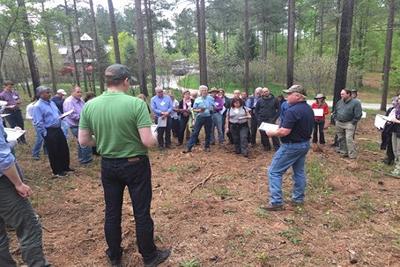Southampton researcher contributes to international report that sheds positive light on the prospects for renewable energy using wood pellets

Clean Carbon member, Caspar Donnison, a doctoral student in bioenergy at the University of Southampton, was one of a group of scientists who went on a Bioenergy Study Tour in the southeastern United States (SE US) in April 2016 to facilitate communication about bioenergy produced in the US.
During the year since the tour, Caspar contributed to the group's report: 'Status and prospects for renewable energy using wood pellets from the southeastern United States', which has just been published. The report's key findings are encouraging. Joining the tour were researchers from the Argonne National Laboratory and the National Renewable Energy Laboratory; foresters and land owners from the south-eastern United States; and scientists from Australia, Brazil, Canada, Denmark, Germany, Poland, Sweden, The Netherlands, the United Kingdom, and the United States. All contributed to the report.

The report, coordinated by the Department of Energy's Oak Ridge National Laboratory (ORNL), asks: “How is the production of wood pellets in the SE US affecting forest systems and the ecosystem services they provide?” To address this question, the authors reviewed current forest conditions and the status of the wood products industry; how pellet production affects ecosystem services and biodiversity; and what methods are in place to monitor changes and protect vulnerable systems.
The report highlights scientific studies that provide evidence that wood pellets in the SE US are a fraction of total forestry operations and can be produced while maintaining or improving forest ecosystem services.
Ecosystem services are protected by the requirement that loggers are trained to apply scientifically-based best management practices in planning and implementing harvest. Bioenergy markets also supplement incomes to private rural landholders and provide an incentive for forest management practices that can simultaneously benefit water quality and wildlife and reduce risk of fire and insect outbreaks. Bioenergy markets can also increase the value of forest land to landowners, thereby decreasing likelihood of conversion to non-forest uses. As with all land-use activities, effects on biodiversity and ecosystem services of producing pellets for bioenergy are highly variable and context specific and can have differential effects across the landscape and over time. Negative impacts can be avoided or reduced by identifying priority areas for conservation and adopting management plans tailored to best achieve multiple goals in production forests.
Monitoring and evaluation are essential to verify that regulations and good practices are achieving goals and to enable timely responses if problems arise. Conducting rigorous research to understand how conditions change in response to management choices requires baseline data, monitoring, and appropriate reference scenarios. Long-term monitoring data on forest conditions should be publicly accessible and utilized to inform adaptive management.

The ongoing debate about the costs and benefits of wood-pellet based bioenergy production in the south-eastern United States requires an understanding of the science and context influencing market decisions associated with its sustainability. The production of wood pellets has garnered much attention as US exports have grown from negligible amounts in the early 2000s to 4.6 million metric tonnes in 2015. Currently, 98% of these pellet exports are shipped to Europe, chiefly the UK, to displace coal in power plants.
The report demonstrates that wood pellet use accounts for only 2% of forest harvest removals. This goes a long way towards refuting the argument that harvesting for biofuel is causing widespread deforestation. The economic argument is also compelling. Wood for energy is not driving harvesting because most of the wood used for pellets is from wood which has already been harvested for use in the building industry. A proportion of that wood does not make the grade and is hence used for making wood pellets.
Visiting key stakeholders in the US forestry industry helped us to put bioenergy into the broader context in the vast Southeast US forest resources. The Tour also highlighted how important it is to understand the economics of the forestry industry in the US
This report demonstrates how science-based analysis can help us make progress toward understanding how production of wood-based pellets can enhance ecosystem services of south-eastern forest systems
Notes for editors
The research report is available at the Wiley online library: http://onlinelibrary.wiley.com/journal/10.1111/(ISSN)1757-1707/earlyview
If you are interested in joining the Clean Carbon USRG fill in the online application